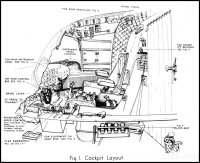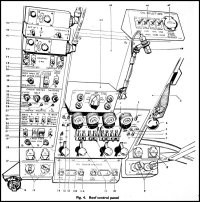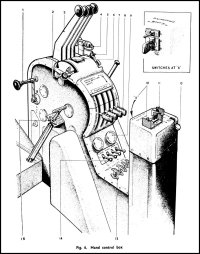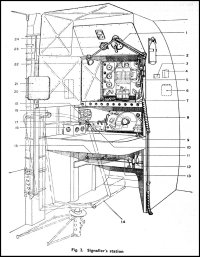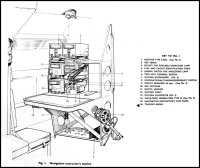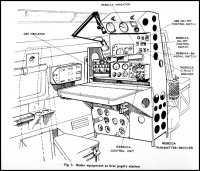

RAF involvement with the Marathon began on 11th September 1950, when the Ministry of Civil Aviation wrote to the Air Ministry, suggesting that with the rearmament of the air force, forty of these aircraft might have a use with the Service as navigational or radio trainers, or as communications aircraft. The Assistant Chief of Air Staff (Ops), Air Commodore DHF Barnett was then asked his opinion on the matter and his response was not encouraging. Barnett felt that the Marathon was neither one thing or another: on the one hand it was larger than the Anson and on the other smaller than the Valetta. As such it fell between the air force's defined range of transport and communications types, comparing unfavourably with its two closest competitors for either being too large for short-range work or too small and restricted in payload and range against the larger machines. He could only suggest that the type might be better suited as a flying classroom, but the advice of ACAS (Training) would have to be sought. Meanwhile it had become apparent that the RAF would be deficient around fifty Anson 21s in 1951/52 and also of Valettas. It certainly seemed that a field full of unsold Marathons could ease this situation, even if they were not the ideal choice. But initially there was little enthusiasm even from ACAS (Training). To fill any gaps, DH Devons were already on order in the Communications role and even in the medium-range transport role, US-built Fairchild C-119s were already under consideration. It was only as a flying classroom , where a deficit of perhaps 20 aircraft had been identified, that there was a possible use, though even in this role it was seen to be a risk to introduce small numbers of a new type into RAF service, and more so since the role ideally required seating for ten pupils and at maximum the Marathon could accommodate only half of that.

Typical of the redundant Marathons being offered to the RAF, G-AMEM was just being received for storage outside Silver City's hangar at Blackbushe at the time of this 1951 photo. It eventually became XA259 with the RAF and was one of the first six Marathon T.11s to go to No.1 Air Navigation School at Hullavington in January 1954. The prominent intake atop the aft fuselage (seen on production Marathons) fed the Daniels Type XH-1g-E cabin combustion heater. It had an associated exhaust below the aft fuselage. (Peter Amos)
By September 1951 the Marathon was also being proposed as a replacement for Lancasters at the Coastal Command Maritime Reconnaissance School. Again, the introdcution of small numbers was seen as a sticking point but the Ministry of Supply was tasked with investigating the requirements. ACAS (Operational Requirements), Air Vice Marshal GW Tuttle, on 22nd September 1951 gave his view by adding in a minute sheet, "It is of interest that BEA do not now want them all. We are endeavouring to find the reason. If it is a bad aircraft we do not want it either". But the point was moot, since a quick investigation revealed that the Shackleton would fill the role at the MR School. However the deficit of Ansons in the Air Navigation Schools was still a concern and here it seemed that Handley Page might finally find a home for its unsold aircraft. ACAS (Training) held off making a decision until his staff had fully investigated the matter but on 30th October 1951 he was able to respond that, "The Marathon, with the modifications proposed by Handley Page, would be suitable for air navigation training, and in view of the impending shortage of Ansons, Wellingtons and Varsities, we would be glad to have as many as are available as soon as possible." Strangely the Marathon then began to be suggested again for the MR School, though in the end this came to nothing. The decision on its use as a navigation trainer continued into 1952 while various departments aired concerns about suitability and cost.
The eventual cancellation of the BEA order in early 1952, allied to a continued lack of other orders, undoubtedly forced the hand of the Ministry of Supply, which at this point had up to forty Marathons sitting unsold. Rather unexpectedly, orders now came in from Burma and West Africa and so fewer Marathons would now be available for the RAF. A cost per aircraft (including conversion) was quoted by HPR at £50,000 against £70,000 for a Vickers Varsity. It seemed a good deal and the Ministry now assumed the Marathon would be cheaper to operate than the Varsity since it was a lower-powered aircraft (though it had previously expressed the oppsite opinion, because the Marathon was four-engined!). A letter dated 1st March 1952 from JJS Shaw to VH Raby at the Air Ministry gave authority to place a requisition, "for 35 Marathon aircraft on the Ministry of Supply within the total cost of £42,000 each" (in other words, less conversion costs). Operational Requirement OR/312 was issued to tidy up the paperwork, and covered a new navigation trainer, to replace the Anson T.21 and also supplement the Wellington and Varsity aircraft. It was seen initially that Marathons would form the total equipment of one Air Navigation School. HPR received authority to proceed with production conversions on 15th May but for some time Handley Page did not receive a contract to convert the Marathons.
The production variant would be known by Handley Page as the HPR.5 and the RAF designation ‘Marathon T. Mk.11’ was applied to the navigation trainers in or before August 1952. Concurrently a batch of serial numbers from XA249 to XA278 was allotted. The mark number 11 (and not 'II') was an intentional decision, in line with other aircraft that had been adapted for RAF use from existing civil aircraft (a good example being the DHC-1 Chipmunk, the first RAF version of which was designated T.10). It is possible that ‘Marathon Mk.10’ was a designation retrospectively applied to VX229 and/or VX231.
On 16th June 1952, the Ministry of Supply issued Requisition No.3918/D to Handley Page, to cover the cost already incurred in the conversion of its existing aircraft mock-up to replicate the interior of the Navigation Trainer, as well as for mocking up the exterior of G-AILH to be externally representative of the T.11, except for radio aerials. Further items in the Requisition covered Contractor's flight trials (not exceeding 5 hours, though in practice they lasted 10 hours and 55 minutes) and applying RAF markings to the flight test aircraft. G-ALVW (soon to become XA250) was also detailed for Trial Installations (TI's) and development work directly associated with the Navigation Trainer role, with flight trials on this aircraft not to exceed 15 hours. The total cost came to £30,000 and was signed off by the Director of Contracts on 17th June.
Handley Page had already done a great deal of work in converting its fuselage mock-up to represent the trainer and on 31st January 1952 a Mock-up Conference, Chaired by Sqn Ldr RY Powell was held at Woodley to inspect it and report on its suitability in meeting the needs of the RAF. The conference noted a few changes to be made, including Gee Mk 2 instead of Mk.3 and fitting of 1154/55 radio in place of the lightweight HF wireless shown in the mock-up. Two intercomm systems were also required to ensure that training chatter didn't interfere with crew operation. Since speed of production was key if a contract were to be placed, only minor alterations were required, unless they were of overriding importance. Interestingly, Handley Page had constructed a ventral bomb-aimer's position in the mock-up, but the conference decided that this was not a requirement for the first 35 aircraft, but that if further Marathons were required, it might become necessary as well as being retro-fitted to existing machines. Associated with this but also held in abeyance, were racks for 25 lb practice bombs.
The following excerpt from a Flight magazine article, “Marathons – Military and Civil” (9th May 1952) makes interesting reading, based as it was upon the Handley Page mock-up for the navigation trainer:
“The modifications required for RAF Marathons are not of a major kind; they amount mainly, as one would expect, to an interior refit.
The engines, de Havilland Gipsy Queen 70/3s, are retained for the RAF Marathons, and in order to give adequate range for the new duties, fuel tankage of 410 gallons is being provided. Four main-wing tanks carry 216 gallons; two new tanks in the outboard engine nacelles hold 130 gallons; and the four standard overload tanks in the wings contain 60 gallons. This is sufficient for an extreme range of 1,400 miles, or 7½ hours' duration at weak mixture cruising. This meets the requirement of five-hour training nights, and the Marathon can also cruise at 15,000ft as called for in the provisional specification, oxygen being provided in RAF versions.
There are stations for a first (or staff) pilot, second pilot, radio operator, navigational instructor, 1st u/t navigator and 2nd u/t navigator. In addition, a "gash bod" might be carried for special exercises or experience. The second pilot could be u/t for four-engined experience or revision, or the seat could be left empty. For some training work the 1st u/t navigator might navigate the aircraft and the instructor could then be a w/op, and the w/op's station be occupied by a pupil.
It is expected that the following equipment will be carried: Gee, Rebecca, radio compass, twin VHF, 1154-55 MF, astro-compass, sextant, radio altimeter, G.4B compass and, when available, ILS with Zero Reader. Two separate intercom systems are to be installed so that instruction can proceed without interfering with flying instructions or vice versa. Four generators are fitted. Detail differences externally visible will be blister windows beside each of the u/t navigators' stations, and an astrodome near the entrance door. A possible retrospective mod is a bomb-aimer's position which would be faired into the underside of the nose on the starboard side. It would be entered through a hatch in place of, or near to, the second pilot's seat. The window nearest to the main door will be hinged to allow a camera to be used for pin-point and turning-point identification.
The navigators' desks are of the large Varsity-type and their seats face backwards and are stressed for 25g. The usual RAF emergency kit is carried, and the escape hatches and doors as provided for civil Marathons are retained. Pilots will notice several changes in the RAF-type instrument panel (the flexible coaming is retained), and a full cross-feed fuel system is now provided. The earlier manual arrangements have been replaced by electric fuel-cocks.
Deliveries with all changes incorporated are due to begin on July 1st. One machine will go to Boscombe again for examination, although the aircraft as such was passed out many months ago. Another will go to a navigational training unit for appraisal. Three aircraft are to be delivered in August, three in September and three in October, and afterwards at four per month.”

The first Marathon to appear in RAF colours was VX229, the second prototype. It was initially flown in natural metal finish with a yellow 'P' (prototype) letter aft of the fuselage roundel. 
This schematic of the T.11 Navigation Trainer shows the location of Instructor, First and Second Pupil stations in the aircraft, all in aft-facing seats. The bulbous 'teardrop' fairing above the centre section (dotted line) housed the Direction Finding loop antenna.
As a precursor to RAF service, the second prototype Marathon, G-AILH, had been allotted from Handley Page to A&AEE at Boscombe Down on 13th May 1952, “to check handling trials with mocked-up astrodome and pear drop windows”. It also featured de-icing overshoes on wing and tailplane leading edges as well as a direction finding (D/F) loop, D/F sense aerial, MBA dipole, ILS marker aerial, beam approach aerial, MBA sword aerial, two Gee aerials and a VHF whip aerial. The aircraft first flew in this configuration on 28th May, when vibration around the astrodome was noted. Further flights and strengthening of panels aft of the astrodome reduced the effects, but ultimately delayed its transfer to Boscombe Down until 23rd June when, now bearing the military markings VX229, it was finally dispatched from Woodley. The aircraft was then involved in a series of handling trials before acceptance of the aircraft for RAF service. These included trials with the aircraft configured at forward and aft Centre of Gravity (C of G) limits, these tests running from 1st July to 13th August. It also performed a test of ASI and altimeter pressure error corrections. VX229 remained with the A&AEE until 8th September, when it was returned to Handley Page, “for removal of astrodome and other equipment fitted for trials at Boscombe”. The A&AEE trials had revealed a number of aspects of the aircraft which were seen as unfavourable or requiring attention and the list read as follows,
1. There was an almost complete absence of a stall warning in the power on, flaps and undercarriage down case. Some form of warning, preferably aerodynamic is desirable under these conditions.
2. The values of stick force per 'g' during recovery from trimmed dives were lower than required by AP.970 at speeds above about 160 knots IAS. In view of the possibility of structural failure resulting from application of quite low stick forces, the elevator control should be made heavier at high speeds or that the CG range or limiting airspeed be restricted.
3. The tail bumper and rear fuselage could easily be damaged by striking the ground, when the aircraft was landed in a tail-down attitude.
4. Damage to the flaps could result, should they be lowered when the main entrance door is open.
5. The pilot's seats are difficult to enter, particularly that of the second pilot.
6. The pilot's seat cushions may foul the flap and undercarriage controls.
7. There was a large stagger between the throttle levers for common engine setting. Throttle levers of equal length for the four engines would be preferred to those fitted.
8. When the friction adjustment for the propeller controls was tightened sufficiently to prevent creep, the controls were difficult to move.
9. Difficulty was experienced in ensuring that the nose wheel steering became disengaged when the control lever was moved.
10. The electric actuation of the trimmers was not liked. Accurate trimming was difficult. In the event of 'runaway' of the elevator trimmer motor, excessively heavy stick forces, that the pilot would be unable to override, would be experienced, particularly at high speed. It is recommended that manually operated trimmers be fitted.
11. The blind flying panels were badly arranged.
12. The fire warning lights positioning was such that they would probably not be noticed except at night.
13. The fuel contents gauge pointers fluctuated in flight, making accurate reading impossible.
This was a serious list of concerns and HPR set about addressing them prior to entry of the type into RAF service. To understand the light elevator stick forces, the company performed a series of tests on XA260 and was able to suggest that by locking the geared elevator tab in the raised position, the stick force was increased and up to 210 knots the aircraft now met the requirements of Air Publication 970. Following the A&AEE test for ASI (airspeed indicator) and altimeter pressure error corrections on VX229, Boscombe Down had highlighted that, “The corrections and also the variation over the speed range, are large and exceed the AP.970 requirements of Chapter 726. The corrections also vary with aircraft weight and configuration [landing gear and/or flaps extended/retracted]. Bearing in mind the intended service role of this aircraft, it is recommended that the ASI system be modified to bring the pressure error corrections within AP.970 limits.” Handley Page therefore conducted further flight trials on VX229 to determine a satisfactory location point for the static vents required for the new Marathon RAF trainer. HPR placed 35 static ports on each side of the nose section of and in two flights from 29th January 1953 determined that three positions gave results that met the AP.970 requirements. One in particular ("vent 20") showed small variations across the speed range and so this location was chosen for the RAF aircraft. A further flight was completed on 5th February with the vent inserted through a standard brass plate fitting and thankfully the results were duplicated. VX229 was then turned over to be prepared at Woodley for freighter duties with the Air Transport Development Unit.
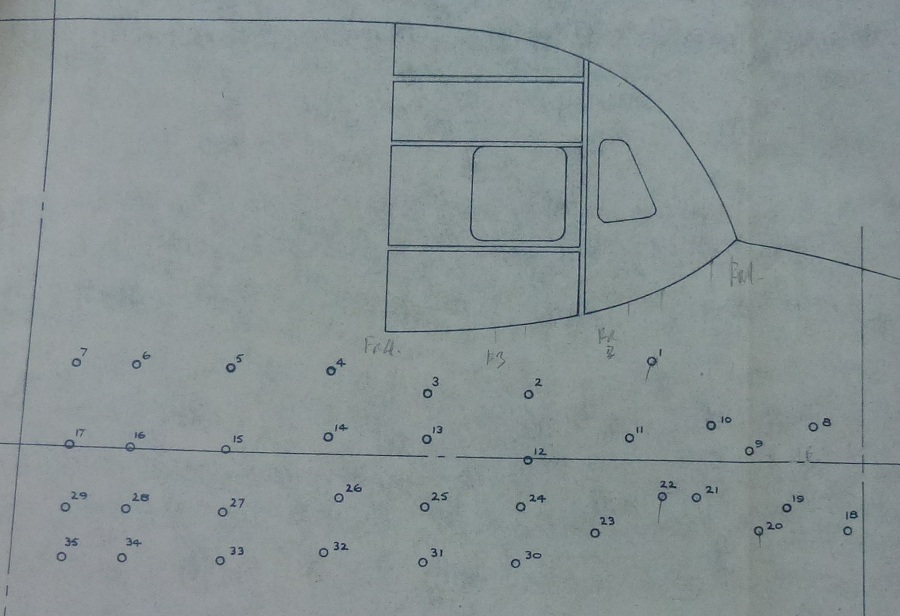
The Ministry of Supply issued Specification No. T130 D&P on 11th September 1952 under the title, "Conversion of Civil Marathon Mks 1 and 1A to RAF Marathon T.Mk.11". Among its requirements was the need for the trainer to carry a full crew plus all instructional equipment and be capable of flying for five hours to tanks dry. Crew would consist of pilot, wireless operator, navigational instructor and two pupils. Provision for fitting dual controls and a second pilot's seat were to be provided, though in service the former was often not installed. The public got its first view of the new trainer at the 1952 SBAC Show at Farnborough, when XA250 was shown in silver overall RAF colours, with yellow training bands around its wings and aft section. WR Burton demonstrated the aircraft, which Flight magazine described as, “Fully equipped”. Burton’s display ended with him landing XA250 with the port outer engine shut down. This aircraft was of course not yet equipped as a navigation trainer and by April 1953 the sequence for conversion of the RAF aircraft had been defined. The order of conversion does not seem to make any great sense, appearing to be entirely random, but was as follows:
The trial installation of Gipsy Queen Mk.174 engines on XA276 was brought about by the cessation of manufacture of the Gipsy Queen 70-3 (Mk.172) and 70-4 (Mk.173) engines already installed in the Marathons. It had thus been decided to convert all T.11s to be equipped with the Gipsy Queen 70 Mk.2 (Mk.174). As a result, in January 1953 a contract revision was drawn up whereby XA276 would be fitted with three Mk.174 engines and a single Mk.173, to perform comparison checks not exceeding 5 flying hours. The remaining Mk.173 would then be up-rated to Mk.174 standard and further flight trials done, not to exceed 10 flying hours.
Numerically the second Marathon T.11, XA250 was subject to a Final Inspection Conference on 30th October 1952. XA250 was then sent to Farnborough for radio installation checks with the RAE on 16th April 1953 and remained there to complete radio trials. Up to 13th May it had completed only 8 hours of flying, with periods of unserviceability grounding it or restricting the tests that could be done. Equipment snags included a malfunctioning Gee receiver unit, a Gee aerial incorrectly assembled, Gee aerial loading unit unserviceable, intercom distorted, AC power supply to the Rebecca overcharging and the M/F fixed aerial incorrectly connected. In addition, two wing fuel tanks required replacement and the engine bearer fittings required modification. The RAE also had unspecified reservations about the aircraft's engine oil system. XA250 was dispatched to Boscombe Down on 24th August and then sent back to Woodley on 31st December 1953 to be brought up to full Marathon T.11 standard. Meanwhile, with RAF Marathons now undergoing conversion at Woodley, HPR were advised on 27th May 1953 that they could finally dispose of its long-serving Marathon mock-up.
Construction Number Registration RAF s/n
102 G-ALVW XA250
131 G-AMHT XA274
111 G-AMEM XA259
113 G-AMEP XA260
121 G-AMGP XA268
125 G-AMGU XA272
108 G-AMDH XA256
119 G-AMGN XA266
123 G-AMGS XA270
116 G-AMEU XA263
137 G-AMHZ XA278
136 G-AMHY XA277
124 G-AMGT XA271
115 G-AMET XA262
114 G-AMER XA261
110 G-AMEL XA258
109 G-AMEK XA257
107 G-AMAY XA255
106 G-AMAX XA254
132 G-AMHU XA275 3 engines only - 1 off for use on Mk.174 trials aircraft
135 G-AMHX XA276 trial installation of Mk.174 engines
117 G-AMEV XA264
118 G-AMEW XA265
120 G-AMGO XA267
122 G-AMGR XA269
103 G-ALVX XA251 solid barrel aircrews
104 G-ALVY XA252 solid barrel aircrews
105 G-ALXR XA254 solid barrel aircrews
101 G-ALUB XA249 solid barrel aircrews
126 G-AMGV XA273 solid barrel aircrews 
The immaculate Marathon T.11 prototype, XA250, pictured at the 1952 Farnborough SBAC show. Of note are the lack of de-icer boots on all leading edges and absence of pitot static ports (usually denoted by a small, oval-shaped panel beneath the forward windscreen) on the nose section. (Bert Clarke via Peter Amos)
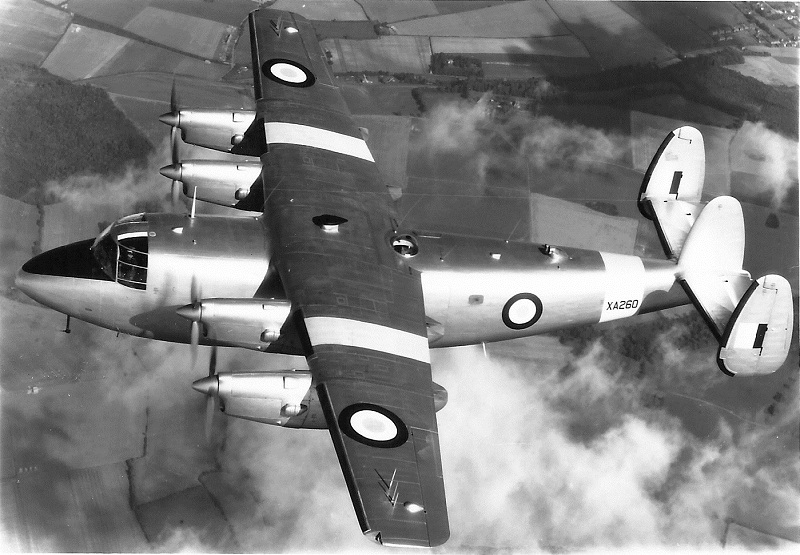
Further Marathons were also involved in the acceptance of the type into service. In May 1953, XA274 was dispatched to the Handling Squadron at RAF Manby for use in compilation of Pilot’s Notes. This requirement was only partially successful as only limited flying was possible before the aircraft had to be grounded for the incorporation of modified engine bearer fittings. It returned to flight on 2nd July and was then flown to Woodley on 29th August for conversion to full T.11 configuration. On 2nd September 1953, XA260 was sent to Boscombe Down for miscellaneous handling checks It remained there until 16th July 1954 when it returned to Handley Page for removal of non-standard equipment.
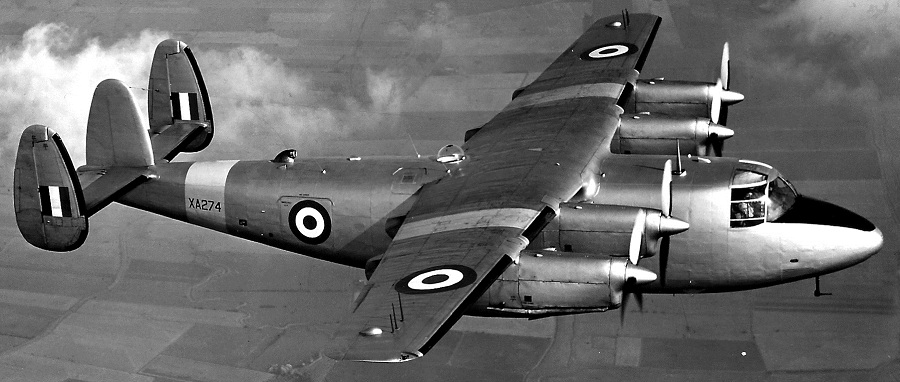
From 10th September 1953, XA250 was subjected to a Navigation Assessment at Boscombe Down, the type's last major hurdle prior to its release for service. Thankfully the final verdict was glowing, the A&AEE report stating that, "The navigational layout of the Marathon T.Mk.11 has been tested on the ground and during some 30 hours day and night flying. The cabin of the aircraft, designed to accommodate two pupil navigators and a navigation instructor, was found to be well planned and adequately equipped; it is spacious and allows easy access to all stations and to the equipment installed. With the exception of search radar, all the established navigational techniques can be successfully exercised, though the astro-navigation training may suffer because the aircraft is not equipped with an automatic pilot. " Only minor recommendations were made and so on 23rd December 1953, Controller Aircraft released the Marathon T.11 aircraft for Service use in temperate and tropical climates, with use in sub-arctic conditions not yet possible , but with cold chamber tests proceeding. The following limitations were imposed:
1. Weight Limitation. The maximum permissible all-up weight is 18,250 lb.
2. Handling Limitations:
a. The maximum permissible speed is restricted to 220 knots IAS, pending completion of trials to higher speeds and development of a modification to increase the stick force – see para (c) below.
b. Manoeuvres. The aircraft may be subjected to the manoeuvres usually employed in the flying of an aircraft of this role. Aerobatics and violent manoeuvres are prohibited.
c. Elevator Control. The basic aircraft has been designed to British Civil Airworthiness requirements current in 1948, which do not specify a minimum value for the stick force. Tests have shown that at the aft C of G the stick force is appreciably less than the minimum required by AP.970 (Air Publication 970 - Design Requirements for Aeroplanes of the Royal Air Force) above 165 knots IAS. Investigation is proceeding to ascertain if the AP.970 requirement can be met by simple Modification.
As a precautionary measure the Service limiting speed has been restricted to 220 knots IAS and a Special Flying Instruction is to be issued to bring this to the notice of pilots.
The Service release also specified a number of essential modifications that had to be embodied before the aircraft could be issued to the training units, including the provision of jacking points beneath the forward fuselage and on the main landing gears, plus a further modification to introduce an improved fuel system which included the deletion of the fuel collector tank in each outboard nacelle.
|
Rebecca, BABS and Gee
“Rebecca” was the wartime name given to the airborne receiver part of a short-range radio navigation system, initially intended for accurate dropping of airborne forces and supplies; the ground-based transponder part of the system was known as “Eureka”. The Rebecca unit was able to calculate the range to the Eureka unit, based on the time it took to get a return signal. A directional antenna aboard the aircraft was then able to provide an accurate direction to the ground signal. It didn't take long to work out that the equipment could easily be adapted to become a navigation aid. Further, it was also adapted for use as a blind-landing system, under the acronym BABS (Beam Approach Beacon Signal). The ground-based component of this system was often housed in a mobile vehicle (a BABS van), which would be located close to the end of the runway during use. Prior to WWII, Gee had been proposed as a short-range blind landing system, but early trials showed that it was effective over large distances and so the system was developed into a long-range navigation tool. During the war, Gee was used by Bomber command to accurately locate targets in total darkness or bad weather. The navigational system comprised a series of three or more transmitters, which produced a number of lines, aligned along a selected direction. Many such transmitters were built and they were arranged such that the lines crossed to form a two-dimensional grid, which was marked onto navigational charts. Thus, by measuring its position relative to the lines generated by two pairs of stations, an aircraft could calculate its position in space. During the War a number of transmitter stations were built to support Gee, which continued in use until 1970, by which time more effective systems had taken over. The airborne side of the Gee Mk. II system consisted of two portions, the R1355 radio receiver, and the Indicator Unit Type 62 (or 62A) oscilloscope. |
Aside from service at No.1 ANS and No.2 ANS (covered elsewhere), there were few other military assignments for the RAF Marathons.
Following its period of testing at Boscombe Down, the second prototype, VX229, was transferred to the Telecommunications Research Establishment at Defford on 24th July 1953 for temporary storage pending further instructions. It was then allotted to the renamed Radar Research Establishment at Defford on 11th November 1953 for radar ranging, Blue Jay and VM8 trials. By August 1955 this aircraft had been fitted with a small thimble-type radar nose and was finally released from its requirement at the RRE on 12th December 1955. The availability of the aircraft was circulated to all MOD establishments, but with no requirements identified, it was withdrawn into store at No.10 MU Hullavington in February 1956 and saw no further service.
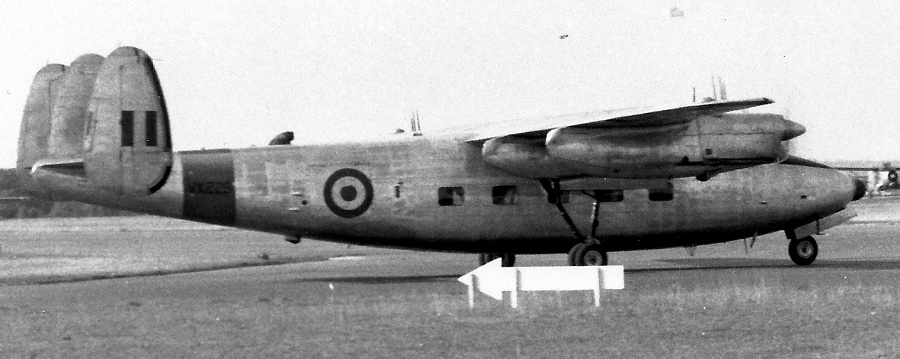

In 1955, the RAE at Farnborough gained a pair of Marathons for use as ferries between Farnborough and the National Aeronautical Establishment (NAE) at Bedford. The aircraft, c/n 130 and c/n 133, were two of those sold to West African Airways in 1952 and retired by the airline early in 1955.Given the military serial numbers XJ830 and XJ831, respectively, the aircraft had briefly regained their civilian registrations G-AMHS and G-AMHV in February 1955 upon transfer to the Ministry of Supply under Contract 6/Acft/11571/CB10(b). They were then allotted to the RAE the following month and apparently known as the ‘Marathon 1C’. XJ830 actually arrived at Farnborough on 2nd March 1955, with XJ831 following two weeks later. They served for three years before XJ830 was sold to the Air Navigation Trading Company and ferried out to Blackpool on 6th October 1958. XJ831 had meantime been allotted to English Electric Ltd at Warton for communication work under a loan agreement and was flown from Farnborough to Warton on 11th March 1958. It returned to the RAE on 20th May and was also sold to Air Navigation Trading, flying from the RAE to Blackpool on 2nd October 1958.

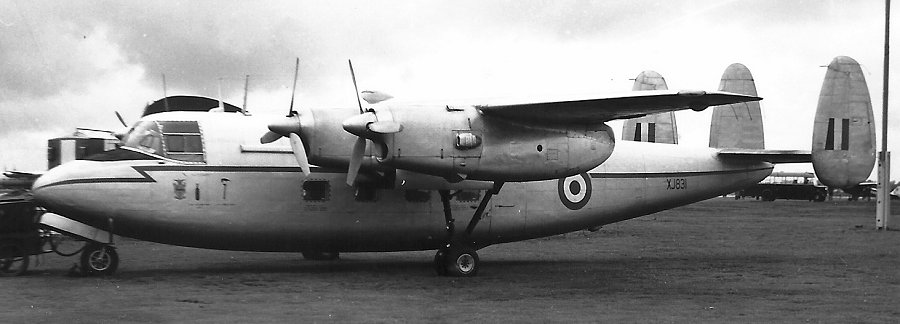
No.8 Flying Training School at Driffield apparently operated one Marathon T.11, XA272. This aircraft had originally been with No.2 ANS at Thorney Island, but following a Cat.3 repair on site there by a 49 MU team, it was allotted to 8 FTS at Driffield on 30th August 1955. It also gained the unit code letter 'E' at this time (it had been ‘H’ with No.2 ANS), and so must have been on the operational strength. No.8 FTS moved to Swinderby on 31st August and just less than a year later, on 30th July 1956 the aircraft was classified with Cat.3 damage. Following another repair on site, this time by a team from Handley Page (Reading) Ltd, it was returned directly to No.2 ANS on 31st May 1957, where it re-gained the code ‘H’.

